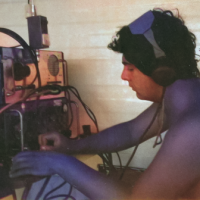SmartSDR v4.1.3 | SmartSDR v4.1.3 Release Notes
SmartSDR v3.10.15 | SmartSDR v3.10.15 Release Notes
The latest 4O3A Genius Product Software and Firmware
Need technical support from FlexRadio? It's as simple as Creating a HelpDesk ticket.
CW Paddle Connected to Manually Send in SmartSDR
I have seen a few interfaces in the internet in which the user can hardware a paddle/key to the serial CTS/DSR to act as a input key to the computer. I have a few questions, as I would like to use a paddle remotely with SmartSDR, without a Maestro.
- Does does Winkeyer work as an input into SmartCAT to then key the radio? My understanding is Winkeyer does not "send" the CW from the key to the computer.
- Has anyone successfully connected/created an interface to key SmartCAT/SmartSDR using a paddle remotely? In my review of CAT it did not appear it can be setup to take COM port inputs as Dit/Dah.
I am aware that we can emulate Winkeyer and send keyboard CW or macros to SmartSDR. However, I am looking for a way to send it manually using a key/paddle.
73,
Eduardo, KC8R
Answers
-
There are a few ways to answer this question, but I need more information to be sure.
If you use a remote WinKeyer it can send CW letters to the radio with WK Flex.
And, no, you can't connect CTS/DSR directly to SmartSDR CAT.
There are 2 ways to make this happen. The Maestro is the best and the fastest as it sends CW elements to the radio directly and you get a local sidetone. It is also the best at mimicking your fist.
The other way, using a WinKeyer, the WinKeyer decodes what you send, turns that in a letter or number and sends that letter or number to the radio. This can be slow-ish at times as the radio has to wait for the letter to come from the WinKeyer first. As an example, an E is sent much faster than a Zero.
While it sounds simple to just mimic CTS and DSR and send that, the devil is in the details when you have to deal with even the slightest network latency, even on a local Lan. This is why FlexRadio did CW the way they did with the sending the cw elements by measuring the time the radio is in TX and RX.
73
0 -
Hi Eduardo:
Mike outlines two ways to send CW, let's re-cap:
1) Using Maestro, which send the code elements directly to your FlexRadio, using the radio API. Essentially this is a bunch of messages "key closed", "key open" and the radio behaviour quickly follows. The Maestro generates a local sidetone, and this works well; if you were to monitor the (remote) radio sidetone, the latency will drive you crazy - don't do this!
2) Use two WinKeyers (one near your FlexRadio, the other wherever you are) and WKFlex. This works, but introduces delay because each letter is saved-up and converted to ASCII before being sent over the Internet. The ASCII is sent to the WinKeyer in your radio room, where it is dissected back into pristine dots and dashes. I've tried this, and I recommend you do not use this method.
There is a third methid which you hint at, and which I use: I use a serial-port and pull-up resistor to key my PC, along with software: RemoteKeyerInterface. It's mildly rough around the edges (you have to re-enter all parameters each time you start it, and manually connect over SmartLink). The software provides local side-tone, and the code-elements are sent directdly to your radio: "Key up", "Key down" and SmartSDR / CAT are NOT INVOLVED at all. This is my choice, and my recommendation. There is no avoiding Internet latency, but in this case it's only the RF which is delayed (so QSK / full-breakin may become challenging) but the sidetone is responsive, adjustable (freq, vol) and pleasant enough.
Circling back to your Q: there is no instance where any of these three methods uses SmartSDR or CAT.
I don't know anything about CWX...
0 -
Just for the records, WKFlex doesn't require two Winkeyers but only one, the one where you are. The other Wikeyer is the Virtual Winkeyer exposed by SmartCAT.
The delay is generated on the radio side and doesn't impact the experience.
The transmitted code is always perfect because is not impacted by any latency.
There is a youtube video about WKFlex, check it out:
(2) Remote CW with WKFlex #cw #morsecode - YouTube
73, Max N5NHJ
1 -
I am not completely sure about this being another potential solution but you might take a look at the CTR2-Micro. It is a nice add-on device for the Flex and several other radios and provides many functions in a small and low-cost package. There are some posts elsewhere on the Flex community about it but here is the website to start your research.
1 -
I appreciate the prompt responses and options. Looks like there are some viable options here to study and try.
Thank you for the support.
Eduardo, KC8R
0
Leave a Comment
Categories
- All Categories
- 377 Community Topics
- 2.1K New Ideas
- 630 The Flea Market
- 8.2K Software
- 113 SmartSDR+
- 6.4K SmartSDR for Windows
- 183 SmartSDR for Maestro and M models
- 428 SmartSDR for Mac
- 271 SmartSDR for iOS
- 258 SmartSDR CAT
- 191 DAX
- 382 SmartSDR API
- 9.3K Radios and Accessories
- 36 Aurora
- 253 FLEX-8000 Signature Series
- 7.2K FLEX-6000 Signature Series
- 945 Maestro
- 55 FlexControl
- 865 FLEX Series (Legacy) Radios
- 921 Genius Products
- 461 Power Genius XL Amplifier
- 336 Tuner Genius XL
- 124 Antenna Genius
- 296 Shack Infrastructure
- 208 Networking
- 455 Remote Operation (SmartLink)
- 144 Contesting
- 787 Peripherals & Station Integration
- 139 Amateur Radio Interests
- 1K Third-Party Software

